The Agriculture and Horticulture Development Board (AHDB) has published a new report urging farmers to assess their businesses and identify actions to reduce the impact of climate change.
The Climate Change Adaptation Report describes how climate change could impact agriculture across multiple temperature increase scenarios, between now and the year 2100, and suggests changes that could be made to protect farming businesses.
Rachael Madeley-Davies, AHDB head of environment, said: “The UK is experiencing less predictable seasons and more frequent and intense weather events. Agriculture is especially vulnerable to these changes because it is directly dependent on the climate, as well as relying on natural assets like soils interacting with complex biological systems.”
Flooding has been highlighted as a high-priority, with growers encouraged to think about the impact of increased rainfall. The Met Office Climate Projections 2018 (UKCP18) suggest that by mid-century, heavy rainfall will have increased by 20%, with average rainfall being 5% above the 1981-2000 average.
Racheal adds: “Many farmers are already aware of the risks caused by flooding, but it’s important this becomes a focus for all. Farmers need to identify any risk areas to their farm in order to futureproof their business.
“Ensuring that soil remains permeable and minimising compaction is an easy win in terms of soil health and adapting to managing increased rainfall and flooding implications on farmland. This could include practical steps such as aeration, minimal tillage and utilising deep-rooted varieties such as festuloloium, cocksfoot and clovers.
“Farmers should also understand watercourses around their farm, including near key infrastructure, and how they cope during periods of prolonged rainfall. It could be that maintenance is required, or investment in terms of water diversion, water capture and adaption or relocation of farm buildings.”
As well as the risks, the report will also highlight where there may be opportunities, such as growing new crops, and a reduction in feed and energy costs.
“The focus for agriculture to date has been around climate mitigation actions, i.e. how agriculture can reduce its environmental impact. There is currently little data at scale of the implementation of actions that could be used to adapt to climate change on farms in the UK and this report fills that gap. Ultimately agriculture needs to begin adapting to, as well as mitigating against, climate change – it’s two sides of the same coin.
“The good news is a lot of the actions required are current best practice such as maintaining soil health for productivity and animal health and welfare.”
The report forms part of the government’s National Adaptation Reporting Power programme fourth round (ARP4). The programme assesses the UK’s planning and resilience to climate change and feeds into the next Climate Change Risk Assessment for the Climate Change Committee (CCC).
For more information go to www.ahdb.org.uk


